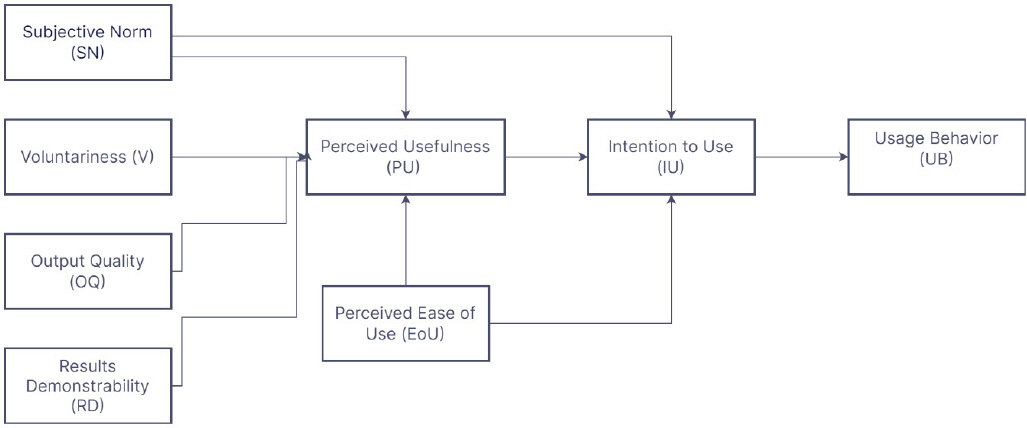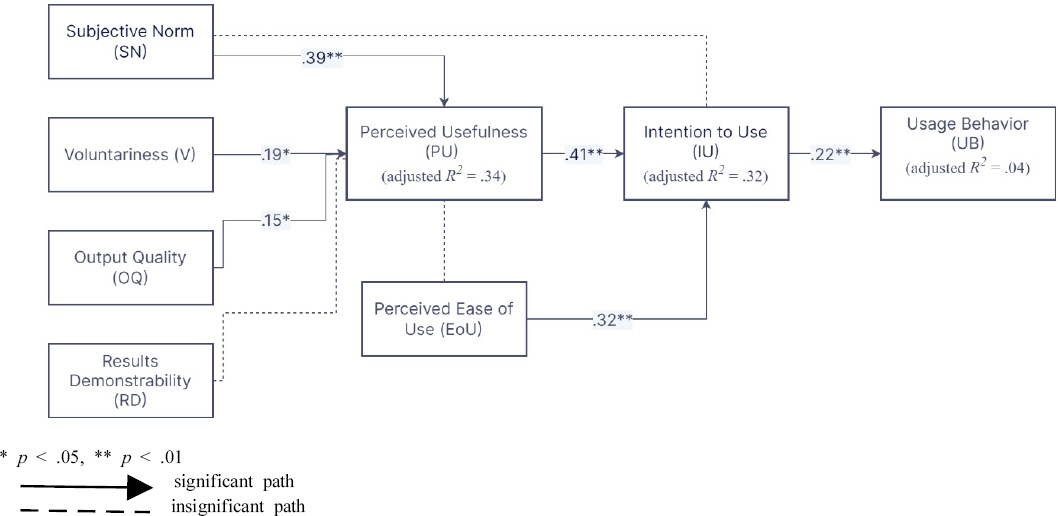Agarwal, R, Prasad, J(1997 The role of innovation characteristics and perceived voluntariness in the acceptance of information technologies, Decision Sciences 28(3), 557-582. https://doi.org/10.1111/j.1540-5915.1997.tb01322.x.
Almusharraf, A, Bailey, D(2023 Machine translation in language acquisition:A study on EFL students'perceptions and practices in Saudi Arabia and South Korea, Journal of Computer Assisted Learning 39(6), 1988-2003. https://doi.org/10.1111/jcal.12857.
Amjad, M, Hussain, R, Siddiq, S(2020 Pakistani ESL learners on the internet:Explorations into factors influencing their online language learning behaviour, Global Language Review 5(3), 155-162. https://doi.org/10.31703/glr.2020(V-III).16.
Ata, M, Debreli, E(2021 Machine translation in the language classroom:Turkish EFL learners'and instructors'perceptions and use,
IAFOR Journal of Education 9(4), 103-122. https://doi.org/10.22492/ije.9.4.06.

Beavers, A. S, Lounsbury, J. W, Richards, J. K, Huck, S. W, Skolits, G. J, Esquivel, S. L(2013 Practical considerations for using exploratory factor analysis in educational research, Practical Assessment, Research, and Evaluation 18(1), 6.https://doi.org/10.7275/qv2q-rk76.
Benda, J(2013 Google translate in the EFL classroom:Taboo or teaching tool? Writing and Pedagogy 5(2), 317-332. https://doi.org/10.1558/wap.v5i2.317.
Byun, H. W(2022). Exploring the use of machine translations for international students in Korea, The Journal of Interpretation and Translation Education 20(4), 67-82.
Chung, E. S(2020 The effect of L2 proficiency on post-editing machine translated texts,
Journal of Asia TEFL 17(1), 182.http://dx.doi.org/10.18823/asiatefl.2020.17.1.11.182.

Davis, F. D(1985). A technology acceptance model for empirically testing new end-user information systems:Theory and results, [Doctoral dissertation, Cambridge, MA:MIT Sloan School of Management].
Davis, F. D(1989 Perceived usefulness, perceived ease of use, and user acceptance of information technology,
MIS Quarterly 13:319-339. https://doi.org/10.2307/249008.

Davis, F. D, Bagozzi, R. P, Warshaw, P. R(1989 User acceptance of computer technology:A comparison of two theoretical models,
Management Sci 35(8), 982-1003. https://doi.org/10.1287/mnsc.35.8.982.

Dennis, M. O(2019). Learner perceptions of using machine translation tools in the EFL classroom,
The SNU Journal of Education Research 28(2), 63-83.

Dziuban, C. D, Shirkey, E. C(1974 When is a correlation matrix appropriate for factor analysis?Some decision rules,
Psychological Bulletin 81(6), 358-361. https://doi.org/10.1037/h0036316.

Fishbein, M, Ajzen, I(1975). Belief, attitude, intention, and behavior:And introduction to theory and research, Addison-Wesley.
Groves, M, Mundt, K(2015 Friend or foe?Google Translate in language for academic purposes, English for Specific Purposes 37:112-121. http://dx.doi.org/10.1016/j.esp.2014.09.001.
Hartwick, J, Barki, H(1994 Explaining the role of user participation in information system use,
Management Science 40(4), 440-465. https://doi.org/10.1287/mnsc.40.4.440.

Hemphill, J. F(2003 Interpreting the magnitudes of correlation coefficients,
American Psychologist 58(1), 78-79. https://doi.org/10.1037/0003-066X.58.1.78.


Jolley, J. R, Maimone, L(2022 Thirty years of machine translation in language teaching and learning:A review of the literature,
L2 Journal 14(1), https://doi.org/10.5070/L214151760.

Jones, S, Richards, A, Cho, Y, Lee, Y. J(2019). Pedagogical ramifications of fourth industrial revolution technology on general English classes from Korean students perspective, Korean Journal of General Education 13(4), 501-532.
Kelly, L. G(1995 History of translation, Koerner E. F. K
Concise history of the language sciences 419-430. Pergamon. https://doi.org/10.1016/c2009-1-28311-0.

Kim, M, Han, S(2023 A case study on integrating Google Translate into college EFL writing instruction,
Korean Journal of English Language and Linguistics 23:1111-1135. https://doi.org/10.15738/kjell.23.202312.1111.

Kit, L. W, Ganapathy, M(2019 The reality of Malaysian ESL teachers'ICT pedagogical practices:Challenges and suggestions,
English Linguistics Research 8(3), 39-48. https://doi.org/10.5430/elr.v8n3p39.


Koh, S(2022 A comparative error analysis of neural machine translation output:based on film corpus, LAK J 30(1), 157-177. https://doi.org/10.24303/lakdoi.2022.30.1.157.
Lee, G, Lee, B(2021 Characteristics of eight Korean EFL young adults'L2 writing using machine translation programs, Multimedia-Assisted Language Learning 24(2), 34-58. https://doi.org/10.15702/mall.2021.24.2.34.
Liu, K, Kwok, H. L, Liu, J, Cheung, A. K(2022 Sustainability and influence of machine translation:perceptions and attitudes of translation instructors and learners in Hong Kong, Sustainability 14(11), 6399.https://doi.org/10.3390/su14116399.
Liu, G, Ma, C(2023 Measuring EFL learners'use of ChatGPT in informal digital learning of English based on the technology acceptance model,
Innovation in Language Learning and Teaching 1-14. https://doi.org/10.1080/17501229.2023.2240316.

Ningsih, S. K, Suherdi, D, Purnawarman, P(2022 Secondary school teachers'perceptions of mobile technology adoption in English as a foreign language learning:Trends and practices,
International Journal of Education and Practice 10(2), 160-170. https://doi.org/10.18488/61.v10i2.3004.


Peterson, R. A(2000 A meta-analysis of variance accounted for and factor loadings in exploratory factor analysis, Marketing Letters 11(3), 261-275. https://doi.org/10.1023/A:1008191211004.
Richards, J. C, Rodgers, T. S(2014). Approaches and methods in language teaching, Cambridge University Press.
Rogers, E. M(1995). Diffusion of innovations, 4th ed. The Free Press.
Shrestha, N(2021 Factor analysis as a tool for survey analysis,
American Journal of Applied Mathematics and Statistics 9(1), 4-11. https://doi.org/10.12691/ajams-9-1-2.

Tavakol, M, Dennick, R(2011 Making sense of Cronbach's alpha,
International Journal of Medical Education 2:53.https://doi.org/10.5116/ijme.4dfb.8dfd.



Veiga, F. J. M, Andrade, A. M. V. D(2021 Critical success factors in accepting technology in the classroom,
International Journal of Emerging Technologies in Learning 16(18), 4-22. https://doi.org/10.3991/ijet.v16i18.23159.


Venkatesh, V, Davis, F. D(2000 A theoretical extension of the technology acceptance model:Four longitudinal field studies,
Management Science 46(2), 186-204. https://doi.org/10.1287/mnsc.46.2.186.11926.

Wen, K. Y. K, Kim Hua, T(2020 ESL teachers'intention in adopting online educational technologies during COVID-19 pandemic, Journal of Education and E-Learning Research 7(4), 387-394. https://doi.org/10.20448/journal.509.2020.74.387.394.










